Introduction to Small Bathroom Vanity with Sink:
A small bathroom vanity is a compact piece of furniture typically installed in small bathrooms with limited space. Its primary purpose is to provide storage for bathroom essentials such as toiletries, towels, and cleaning supplies, while also serving as a functional area for grooming and hygiene tasks. Small vanities, commonly used when you do bathroom remodeling, often feature a sink or basin integrated into the top surface, allowing for convenient handwashing and other washing activities.
In this article, we’ll discuss 10 key factors for a small bathroom vanity with sinks. We’ll cover the sizes of vanities, materials, standard height, smart storage solutions, faucet options, mirror selection, installation methods, and safety tips. Stay tuned for practical advice and basic information on vanities to make your small bathroom both stylish and functional.
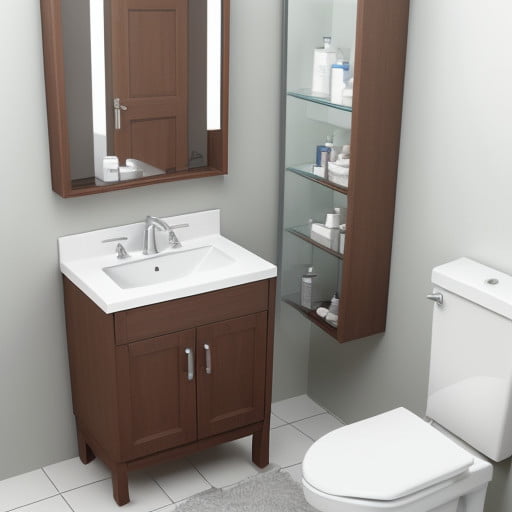
Content Outlines for basic factors of Small Bathroom Vanity with Sink:
1. Size Options for Vanity
2. Sink Sizes for Vanity
3. Standard Vanity Height
4. Vanity Material Types
5. Sink Material Options
6. Storage Choices for Vanity
7. Faucet Installation Basics
8. Importance of Vanity Mirrors
9. Vanity Installation Steps
10. Safety Tips for Vanity
Conclusion
FAQs
1. Size Options for Vanity:
When it comes to the size of small vanities, it’s crucial to consider the dimensions of your existing bathroom space to ensure a perfect fit. Let’s break it down into three common small bathroom sizes along with suitable vanity dimensions:
A. Tiny Bathroom (Dimensions: 4ft x 5ft):
For a tiny bathroom, consider choosing a small vanity with dimensions typically ranging from 16 to 24 inches in length and a width between 10 to 18 inches, depending on your personal preference and style. This compact size ensures a snug fit within the limited space of your bathroom without dominating the area.
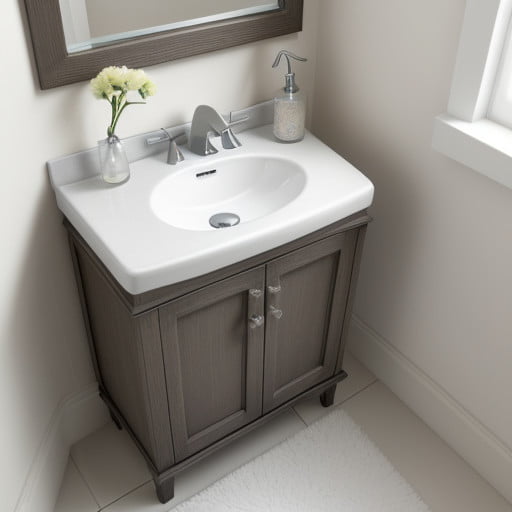
B. Small Bathroom (Dimensions: 5ft x 8ft):
In a small bathroom, you have a bit more space to work with. It’s advisable to consider a vanity with dimensions typically ranging from 24 to 36 inches in length and a width between 18 to 22 inches, depending on your personal preference and style. It provides sufficient storage and countertop space without making the room feel cramped.
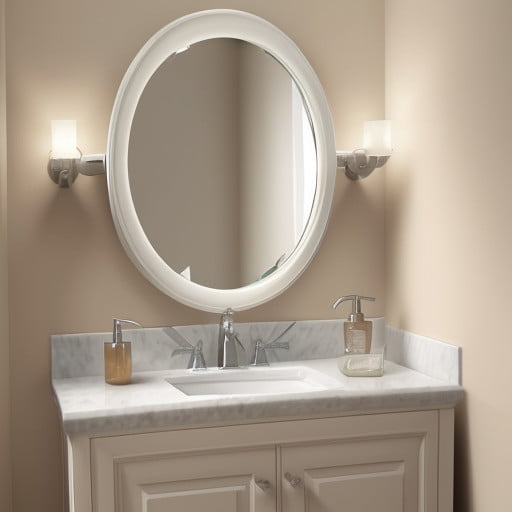
C. Medium Bathroom (Dimensions: 6ft x 10ft):
In a medium-sized bathroom, you have more space to work with, allowing for a slightly larger vanity. Consider looking for options with dimensions typically ranging from 36 to 48 inches in length and a width between 18 to 22 inches, depending on your personal preference and style. It offers ample storage and countertop space while ensuring a balanced and proportional look in the room.

2. Sink Sizes for Vanity:
The vanity sink is a basin or bowl-like fixture attached to a vanity countertop, used for washing hands, faces, and other personal hygiene tasks in the bathroom.
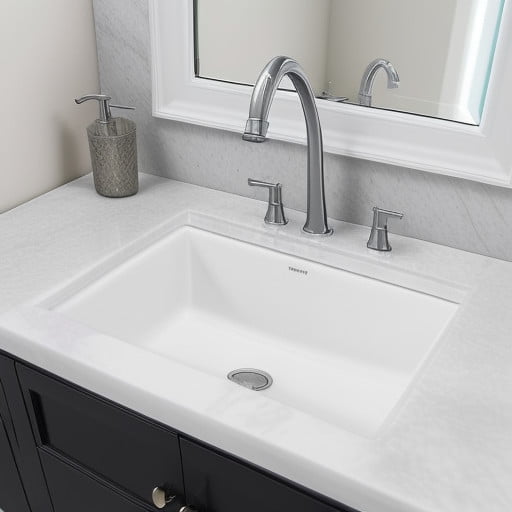
For small vanities, sinks typically come in a different range of dimensions to suit different needs and preferences. Following are the different sizes of sink that could be available in the market:
A. Rectangular Sink (Undermount or Drop-In):
Length: 15 to 24 inches
Width: 10 to 20 inches
Depth: 5 to 8 inches
B. Round Sink (Vessel or Drop-In):
Diameter: 12 to 20 inches
Depth: 5 to 8 inches
C. Square Sink (Vessel or Drop-In):
Length: 12 to 20 inches
Width: 12 to 20 inches
Depth: 5 to 8 inches
3. Standard Vanity Height:
The standard height for fixing a small bathroom vanity with sink typically ranges from 30 to 36 inches from the existing floor. However, in the market, vanities are available at different heights, but it’s crucial to measure the available space accurately to ensure a comfortable and ergonomic fit.
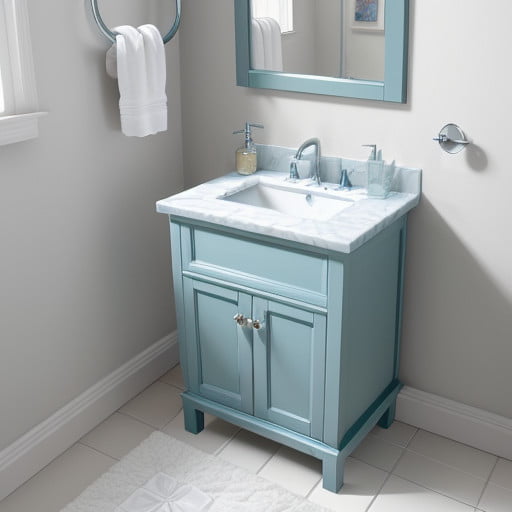
4. Vanity Material Types:
The material for a vanity refers to the substances utilized for constructing the vanity, determining its durability, appearance, and overall quality.
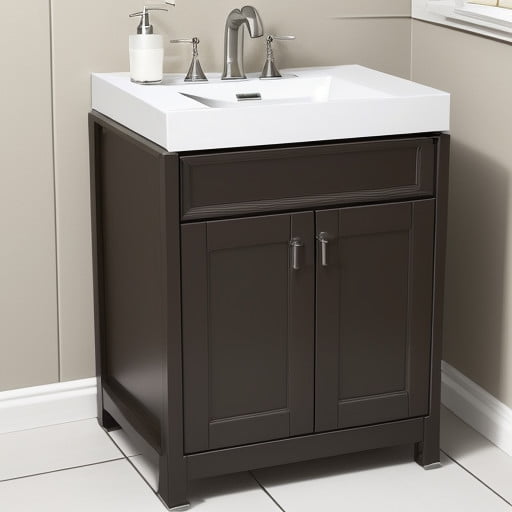
Here are the common materials used for crafting stylish bathroom vanities:
A. Wood:
Offers durability and versatility, including oak, maple, pine, and cherry.
B. MDF (Medium-Density Fiberboard):
Known for its affordability and a smooth finish.
C. Plywood:
Provides strength and stability for vanity construction.
D. Stainless Steel:
Offers a modern, sleek look with durability and corrosion resistance.
E. Glass:
The Tempered glass adds elegance and sophistication to the bathroom, available in various styles.
F. Marble/Granite:
Provides durability and a luxurious appeal, though may require maintenance.
G. Porcelain/Ceramic:
A popular choice for vanities due to durability, easy maintenance, and variety of styles.
H. Corian:
A solid surface material is known for its seamless appearance, durability, and stain resistance.
I. PVC Fiberboard:
Engineered for moisture resistance, affordability, and ease of installation, it is suitable for bathroom vanities.
These materials cater to different preferences and budgets while ensuring quality and functionality for all vanities.
5. Sink Material Options:
Sinks for small vanities are available in various under-mentioned materials, and each material has its unique characteristics, such as durability, stain resistance, and ease of maintenance.
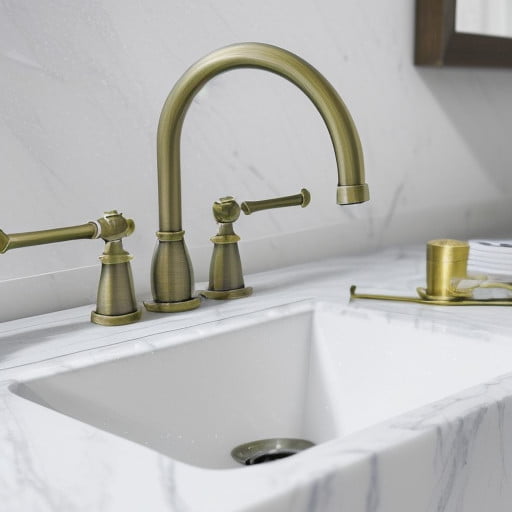
A. Porcelain/Ceramic:
Durable and easy to clean, these are available in various styles.
B. Stainless Steel:
Sleek and resistant to stains and corrosion, it is ideal for modern bathrooms.
C. Cast Iron:
Classic and durable with a vintage appearance, available in different colors.
D. Granite/Composite:
Modern and heat-resistant, offering durability and style.
E. Glass:
Elegant and sophisticated, it adds a touch of luxury to bathrooms.
F. Copper:
Rustic and antimicrobial, it develops a natural patina over time.
G. Marble/Stone:
Luxurious and durable, it is available in a variety of colors and patterns.
H. Acrylic:
Lightweight and affordable, it comes in various colors and styles.
I. Corian:
A solid surface material is known for its seamless appearance, durability, and stain resistance offering versatility in design and color options.
These materials provide homeowners with a range of choices to suit their preferences, budget, and the overall aesthetic of their bathroom.
6. Storage Choices for Vanity:
Storage Options for Small Vanities refers to the various methods and features available to maximize storage space within a compact vanity unit in a small bathroom. These solutions typically include:

A. Drawers:
Ideal for organizing smaller items such as cosmetics, toiletries, and hair accessories.
B. Cabinets:
Provide concealed storage for bulkier items like towels, toilet paper, and cleaning supplies.
C. Shelves:
Perfect for displaying decorative items or storing frequently used items within easy reach.
Related Article: Bathroom Shelves: A Perfect Guide To Stylish Storage Solution
D. Under-sink Storage:
Utilizes the space beneath the sink for storing cleaning supplies, spare toiletries, or baskets of smaller items.
E. Built-in Dividers:
Offer segmented compartments within drawers or cabinets to keep items neatly organized and easily accessible.
F. Over-the-door Organizers:
Hang over the vanity cabinet door to store items such as hair styling tools, brushes, and makeup.
G. Wall-mounted Storage:
Includes racks, hooks, or baskets mounted on the wall above the vanity for additional storage of towels or toiletries.
These storage options help optimize the functionality of small vanities while keeping the bathroom clutter-free and organized.
Related Article: 35 Brilliant Ideas For Bathroom Storage Cabinet
7. Faucet Installation Basics:
The faucet, or Sink Mixer is the tap or fixture attached to the sink in small vanities. It controls the flow and temperature of water for washing hands and other daily tasks. These Faucets come in different styles and finishes, adding both function and style to the vanity area. For small vanities, you can choose from a variety of following faucet options:

A. Single-Hole Faucets:
They have one handle and are compact, perfect for small spaces.
B. Centerset Faucets:
These combine the spout and handles into one unit, saving space.
C. Wall-Mounted Faucets:
Installed on the wall, they free up countertop space and look modern.
D. Vessel Sink Faucets:
Designed for tall vessel sinks, they add style to small vanities.
E. Bridge Faucets:
These faucets are Traditional in look, they connect the hot and cold handles with a bridge shape, adding beauty and elegance.
8. Importance of Vanity Mirrors:
A small mirror is a compact reflective surface typically installed above vanities. Its primary function is to aid in personal grooming activities such as applying makeup, shaving, or styling hair. Small vanity mirrors come in various shapes, sizes, and designs, offering both functionality and aesthetic enhancement to the bathroom space.
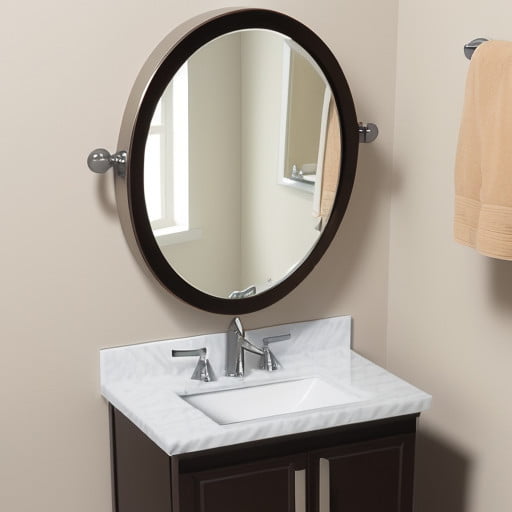
A. Single Mirror:
A single mirror that covers the width of the vanity provides a streamlined and cohesive look, suitable for smaller vanity setups.
B. Multiple Mirrors:
Opting for multiple smaller mirrors or mirror panels can create an interesting visual effect while accommodating the size of the vanity.
C. Round Mirrors:
Round mirrors are space-efficient and add a touch of elegance to small vanity areas, making them a popular choice for compact spaces.
D. Oval Mirrors:
Similar to round mirrors, oval mirrors offer a soft and flattering reflection while maximizing wall space above the vanity.
E. Rectangular Mirrors:
Rectangular mirrors are versatile and can be tailored to fit the width of the vanity, providing a classic and functional option for small spaces.
9. Vanity Installation Steps:
Installing a small bathroom vanity with sink can be a straightforward process when following these basic steps:
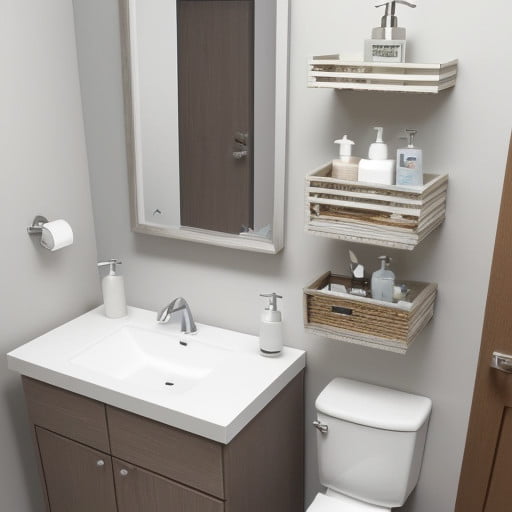
A. Prepare the Space:
Clear the area where the vanity will be installed, removing any existing fixtures or debris. Ensure the plumbing and electrical connections are in place, safe, and ready for installation.
B. Measurements and Markings:
Use a tape measure to determine the exact dimensions of the vanity and mark the positions for mounting screws or brackets on the wall.
C. Mounting the Vanity:
Position the vanity against the wall at the desired height from 30 to 36 inches from the existing floor and alignment, ensuring it is level. Secure the vanities to the wall using mounting screws or brackets, ensuring stability and support.
E. Connecting Plumbing:
Install the faucet or sink mixer according to the manufacturer’s instructions, connecting the hot and cold water supply lines. Connect the drain pipe to the sink drain, ensuring a tight seal to prevent leaks.
F. Sealing Edges:
Apply a bead of silicone caulk along the edges of the vanity where it meets the wall and floor, creating a watertight seal to prevent moisture damage.
G. Securing Countertop:
If the vanity includes a countertop, secure it to the base using adhesive or mounting brackets, ensuring a snug fit.
H. Finishing Touches:
Install any additional accessories or features, such as drawers, shelves, or mirrors, according to the manufacturer’s instructions. Double-check all connections and fixtures for proper alignment and functionality.
I. Cleaning Up:
Wipe down the vanity and surrounding area to remove any dust or debris, leaving the installation area clean and tidy.
Following these steps will ensure a successful installation of your small vanities, providing both functionality and aesthetic appeal to your bathroom space. If you’re unsure about any aspect of the installation process, consider consulting a professional plumber or contractor for assistance.
10. Safety Tips for Vanity:
Following are the safety and maintenance tips for vanity to keep clean and safe.
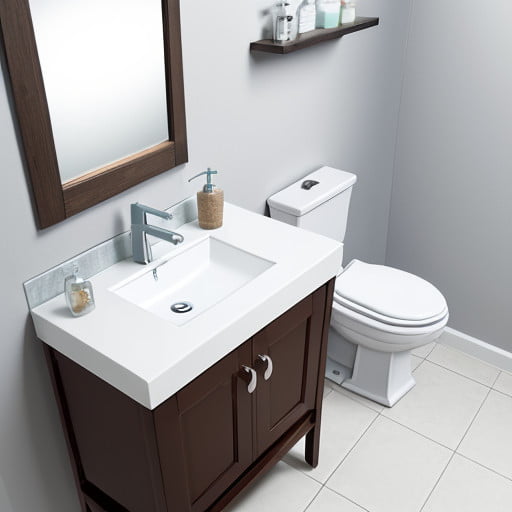
A. Regular Cleaning:
Keep the vanity clean by wiping down surfaces regularly with a mild detergent and water solution to remove dirt, grime, and soap residue. avoid harsh cleaners that could harm the surface.
B. Preventing Water Damage:
Wipe up any spills or splashes immediately to prevent water damage to the vanities surface and surrounding areas. Ensure that the vanity is properly sealed to prevent moisture from seeping into wood or MDF materials.
C. Avoiding Harsh Chemicals:
Avoid using harsh chemical cleaners or abrasive materials on the vanity surface, as they can cause damage or discoloration. Opt for gentle cleaning solutions and non-abrasive cleaning tools to preserve the finish.
D. Inspecting for Leaks:
Regularly inspect the plumbing connections and faucet for any signs of leaks or dripping. Address any leaks promptly to prevent water damage to the vanity and surrounding areas.
E. Proper Ventilation:
Ensure proper ventilation in the bathroom to prevent moisture buildup, which can lead to mold and mildew growth on the vanity surface. Use exhaust fans or open windows during and after showering to promote airflow and reduce humidity levels.
F. Avoiding Heavy Loads:
Avoid placing excessive weight or pressure on the vanity surface to prevent damage or warping, especially with lightweight materials like MDF or particleboard. Use caution when leaning or sitting on the vanity.
G. Securing Loose Hardware:
Periodically check and tighten any loose screws, handles, or knobs on the vanity to prevent them from becoming a safety hazard or causing damage to the vanity surface.
H. Proper Use of Electrical Outlets:
If the vanity includes electrical outlets or fixtures, ensure they are installed and used according to safety guidelines to prevent electrical hazards. Keep cords and appliances away from water sources.
I. Childproofing:
If children are present in the household, consider installing childproof locks on vanity cabinets to prevent access to potentially harmful cleaning supplies or sharp objects.
Conclusion:
The purpose of this blog post is to provide readers with essential information and guidance on selecting and installing a small bathroom vanity with sink. By addressing common concerns and considerations such as size options, material choices, storage solutions, maintenance tips, and safety precautions, the aim is to empower readers to make informed decisions when upgrading or renovating their bathroom spaces.
FAQs (Frequently Asked Questions)
1. What vanity size should I choose for a corner bathroom layout?
For a corner bathroom layout, select a corner vanity with dimensions that fit the available space, typically ranging from 24 to 36 inches in length and width, allowing for easy access and optimal use of the corner area.
2. How do I determine the ideal vanity size for my small bathroom?
Measure the available space and consider factors such as room layout, door swing, and clearance requirements to determine the appropriate vanities size that fits comfortably and enhances the functionality of the bathroom.
3. Can I customize a vanity to fit a specific space in my small bathroom?
Yes, explore custom options for vanity size, shape, and configuration to maximize space utilization and tailor the vanities to your small toilet layout and design preferences.
4. What vanity sizes are suitable for a powder room or guest bathroom?
For a powder room, consider a compact vanity size ranging from 16 to 30 inches in length and 9 to 18 inches in width to provide essential functionality without overpowering the space.
5. Can I install a vanity in a small bathroom with a pedestal sink?
Yes, opt for a small vanity with dimensions that complement the pedestal sink and fit the available space, providing additional storage and countertop space without overcrowding the room.
6. How do I choose the right vanity size for a shared bathroom?
Consider the needs and preferences of all users and select a vanity size that offers adequate storage and countertop space for toiletries and personal items while ensuring sufficient clearance and functionality for shared use.
7. Can I install a floating vanity in a small bathroom?
Yes, floating vanities are space-saving options that can be customized to fit small bathroom layouts, providing storage and style without taking up floor space.
8. What tools are needed for installing a small vanity?
Basic tools such as a tape measure, level, screwdriver, drill, and silicone caulk are typically required for vanities installation.
9. How do I make a small vanity appear larger in a tiny bathroom?
Choose a vanity with clean lines and a light color palette to create a sense of openness and airiness in a tiny bathroom, visually expanding the space and enhancing its overall appeal.
10. What are the advantages of using Corian for vanity construction?
Corian offers a seamless appearance, durability, and stain resistance, providing versatility in design and color options for vanity surfaces.

F*ckin’ amazing things here. I’m very glad to see your article. Thank you so much and i am looking ahead to contact you. Will you kindly drop me a mail?
yes, how can i help you